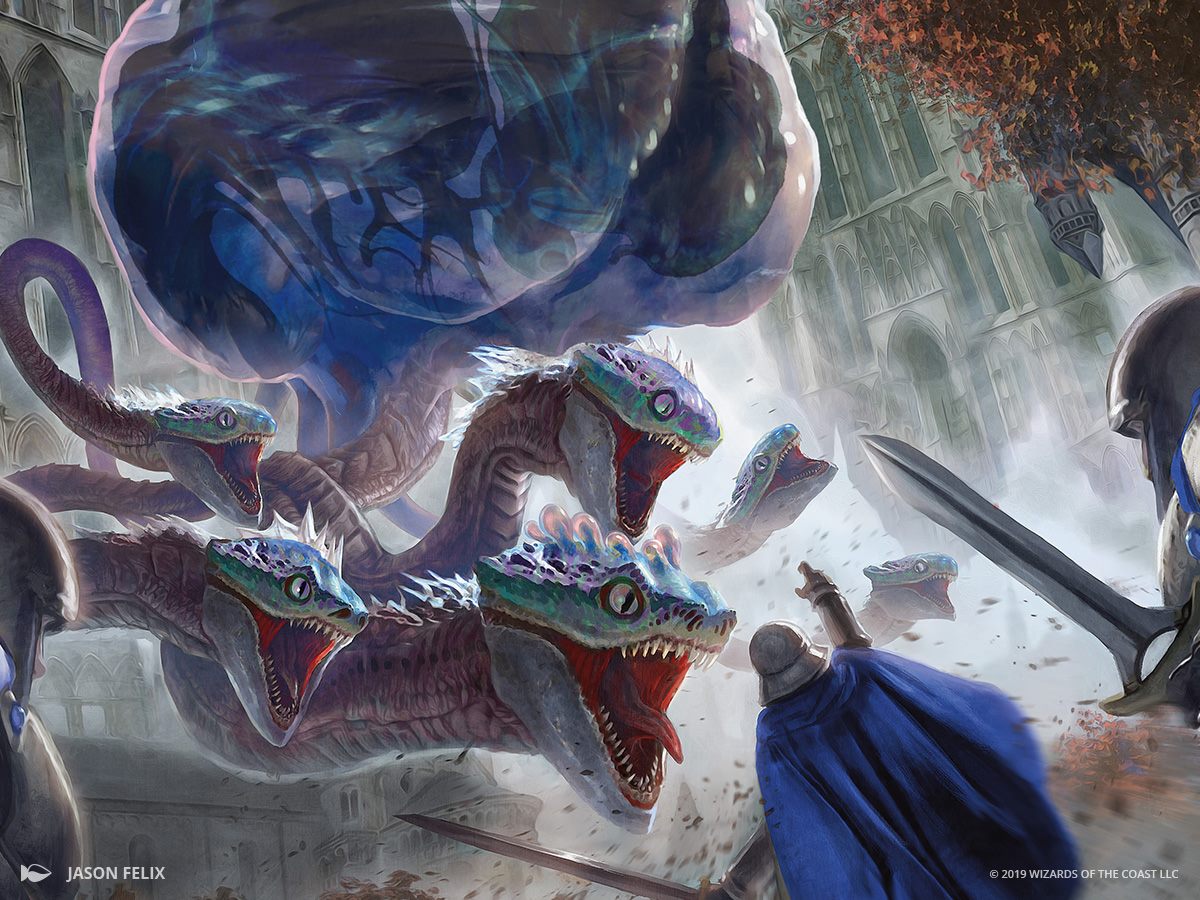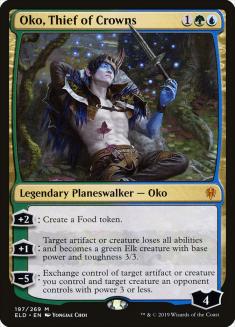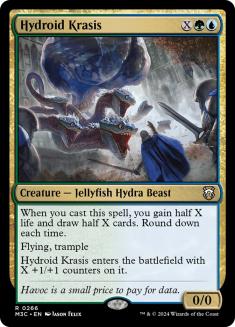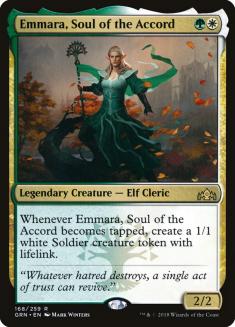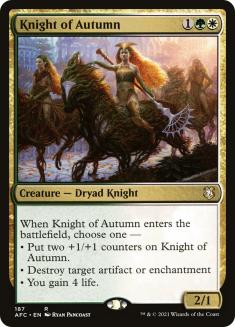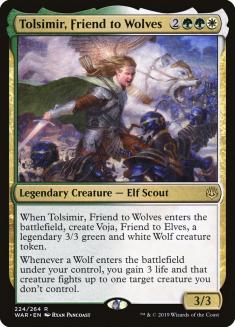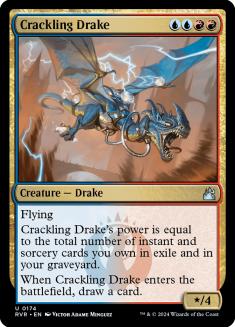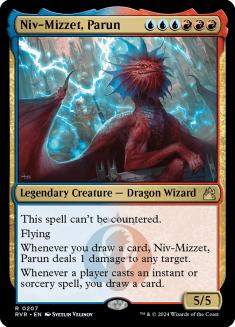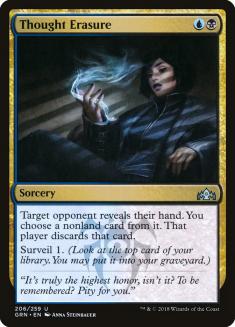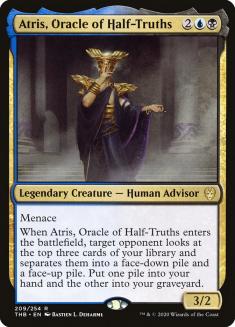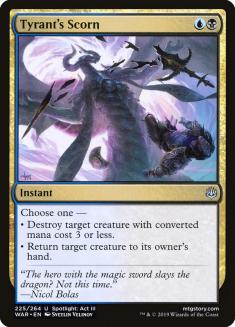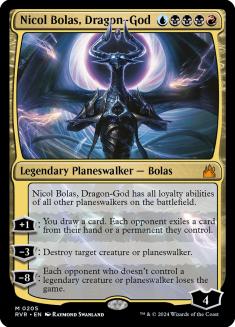With the birth of MagicFest Online, Theros Beyond Death Standard is seeing an incredible surge of interest late into its lifespan. You’d expect Standard to be mostly mined two weeks away from a new set’s release, but a lack of high-stakes tournaments leading up to this moment means there are still edges to be gained with clever deckbuilding. Let’s look at some of the decks that found success this weekend, as well as some innovative lists that might be ready for prime time with a bit more tuning.
Creatures (14)
Planeswalkers (3)
Lands (29)
Spells (14)

Creatures (8)
Planeswalkers (10)
Lands (29)
Spells (13)

Creatures (17)
Planeswalkers (3)
Lands (28)
Spells (12)

Creatures (4)
Lands (29)
Spells (27)
- 4 Opt
- 2 Chemister's Insight
- 4 Expansion
- 4 Growth Spiral
- 4 Wilderness Reclamation
- 2 Aether Gust
- 1 Mystical Dispute
- 1 Scorching Dragonfire
- 2 Storm's Wrath
- 3 Thassa's Intervention
Sideboard

To steal an old joke, Standard is obviously healthy because you can win with any play style you want. Mark Jacobson won the entire tournament with Simic Midrange. Ivan Floch had a strong showing with Simic Control. Lito Biala showed off the power of Simic Ramp. Finally, Danielle Ingallinera rounded out the squad with Simic Combo.

At this point, I am convinced that Momir Vig has taken control of someone on Magic’s design team. Let’s do some comparisons.
These are the three best Simic cards in Standard-legal sets. Obviously Oko has hit the bench, but there is a very good case that Growth Spiral deserves a spot in this Top 3 anyway, and Tamiyo, Collector of Tales; Frilled Mystic; and Risen Reef have been Standard-defining cards during their run. How do these top cards line up against the best of some other guilds?
Oh no. Well, white has been unquestionably underpowered as of late. I’m sure things get better if we look at some guilds without white in them.
Huh. Only one of these cards is even playable.
All right, that’s quite enough.
Simic cards are beyond ridiculous right now and I think you need a very good reason to talk yourself out of playing them. But there is still valid debate regarding which Simic-based deck is the correct one to play. As is often the case when it comes to Magic, the answer is complicated. As far as personal order of preference, I’d rank the Simic-based decks as follows:
- Temur Reclamation
- Bant Midrange
- Simic Ramp
- Sultai Midrange
With the birth of a new Magic tournament series, we’ve also gained access to a lot of data. I’ve been checking up with mtgmeta.io to see what’s done well throughout these qualifiers, and there’s no denying the impressive performance of Temur Reclamation.
Temur Reclamation has two big selling points in the current metagame. The first is a clear path forward against the reigning champion, Sultai Midrange. Countermagic is at its best against an opponent trying to resolve nothing but haymakers, and Temur Reclamation gets to play the extremely flexible Thassa’s Intervention on top of the usual Aether Gusts, Mystical Disputes, and Negates. In the battle of six-mana sorceries versus the deck built to play at instant speed, I’m going with the speedier option every time.
The second huge advantage Temur Reclamation holds is an excellent matchup against Rakdos Sacrifice. Most builds of Rakdos Sacrifice trend towards midrange and therefore find themselves in the unenviable position of being the smaller midrange deck against Temur Reclamation. While the best versions of Rakdos Sacrifice address this concern, they still face an uphill battle once Temur Reclamation gets to max out on removal spells in sideboard games. Rakdos Sacrifice also is doing Temur Reclamation’s dirty work by preventing any other aggressive creature decks from being viable. Reclaiming a bunch of the slots previously taken by Storm’s Wrath and repurposing them for the true metagame has bolstered the deck’s win percentage.
The main concession Temur Reclamation makes compared to the other Simic-based decks is a worse Jeskai Fires matchup. As evidenced by Jeskai Fires’s absence from the Top 8, I think it’s finally time for Jeskai Fires’s representation to trend down. Some of its best matchups like Azorius Control, Mono-Red Aggro, and Temur Adventures are finally starting to disappear from the metagame. Meanwhile, Bant and Sultai Midrange have found viable gameplans against the format boogeyman. Jeskai Fires started the week as the best deck. Its footing atop the mountain looks much more precarious today. If a fall from grace comes to fruition, Temur Reclamation is the top choice for this coming weekend.
While Sultai Midrange took down this tournament, I’ve seen little evidence in data or my own play that suggests it has any advantage over any of the other Simic-based lists. That’s not to say it’s a bad deck. It just has an even matchup spread and little room to exploit other portions of the metagame. You’ll play a bunch of close matches, and if you’re an incredible player like Mark Jacobson, you might still walk away with a trophy. But a slightly better Jeskai Fires matchup is not enough to pull me towards Sultai when Bant can claim similar edges and has Teferi, Time Raveler and Elspeth Conquers Death to dodge the ridiculous numbers of maindeck Aether Gusts we’re presently seeing. Casualties of War has no such advantage. This difference is well reflected in the Temur Reclamation matchup, which is even to favorable as Bant, but solidly unfavorable as Sultai.
Simic Ramp is clearly the move if you believe that Bant Midrange and Sultai Midrange are destined to become over-represented. With the hyper-linear focus on the core Simic gameplan of snowballing advantages, Simic Ramp cares little about the interactivity of its brethren and achieves the massive battlefields the archetype is known for with far more regularity. Agent of Treachery alongside Quasiduplicate is another potential trump, but I still like Thassa, Deep-Dwelling in the synergy spot a bit more. It just carries games that no other card could.
Unfortunately, Simic Ramp really struggles against the non-Sultai and Bant portions of the format, including an abysmal matchup against Temur Reclamation and Rakdos Sacrifice. Choosing to play this archetype requires a lot of confidence in your metagame reads, and while Jacobson’s win should send more people towards Sultai Midrange, I think the format will remain too wide to make this kind of risky gambit.
Why, though? Are there actually strategies good enough to pull people away from a Simic core that seems almost comically overpowered? Some folks have made a good argument.
Creatures (29)
- 4 Midnight Reaper
- 3 Gutterbones
- 4 Priest of Forgotten Gods
- 4 Dreadhorde Butcher
- 4 Mayhem Devil
- 2 Robber of the Rich
- 4 Cauldron Familiar
- 4 Woe Strider
Lands (23)
Spells (8)

When it comes to Rakdos Sacrifice, there isn’t a person on the planet I trust more than Ashley. She has been almost singularly devoted to the archetype for ages now, and it shows in her card selection. Her emphasis on two-drops like Dreadhorde Butcher and Robber of the Rich has pushed Rakdos Sacrifice back towards the more aggressive side of the spectrum. This makes perfect sense and helps avoid the pitfall of becoming the smaller midrange deck.
Instead, Ashley’s build can leverage early damage to put opponents in the squeeze in later turns. Without the vulnerability created by aggressive starts, the Simic-based decks have time to play around things like Claim the Firstborn blowouts, and eventually leverage their higher card quality to pull ahead. If the Rakdos Sacrifice player can dictate the pace of play through aggression, the Simic pilot is left with no choice but to cast spells at the earliest opportunity and hope they can fade potential punishes.
All this comes at little cost to the core engine, which still grants Rakdos Sacrifice tremendous game against any small-ball aggressive decks foolish enough to step up to the plate. Rakdos Sacrifice posted the highest winrate last week according to mtgmeta.io’s data, and Ashley’s list seems a step beyond the stock builds I’ve seen floating around. With strong matchups against Bant and Sultai Midrange, I expect to see this deck everywhere this week.
Creatures (4)
Planeswalkers (14)
- 2 Liliana, Dreadhorde General
- 4 Teferi, Time Raveler
- 4 Nicol Bolas, Dragon-God
- 4 Narset, Parter of Veils
Lands (26)
Spells (16)

This latest take on a planeswalker-heavy strategy has me questioning what year I’ve woken up in. These decks look like the spiritual successors to Esper Hero, and I’m not at all shocked to see a few copies of Hero of Precinct One hanging out in the sideboard. We’ve even got Command the Dreadhorde to go full 2019. I’ll be honest: I don’t know what to make of Bolun’s deck yet. It only hit my radar in the middle of last week, and the sample sizes for this deck are too small to collect any reliable data.
On one hand, I love the emphasis on threats without vulnerability to Aether Gust like Liliana, Dreadhorde General and Elspeth Conquers Death. It also feels like Narset, Parter of Veils demands a home in this format, given its propensity for shutting down Simic’s burst card drawing. However, Esper Hero has mostly been a proven miss thus far in Theros Beyond Death Standard. This is the same core with worse mana and Nicol Bolas, Dragon-God thrown on top. That card is, laughably, vulnerable to both Aether Gust and Mystical Dispute. I’m also not convinced its effect is big enough for the world we presently live in.
The most damning thing I can say about this deck is that it tries to operate with the “correct” amount of mana. Think about the rest of Theros Beyond Death Standard. Wilderness Reclamation, Priest of Forgotten Gods, Nissa, Uro, Growth Spiral, Fires of Invention… the entire format laughs at the idea of traditional mana progression. Decks that seek to play fair like Azorius Control and Jund Sacrifice have completely disappeared from the format, mostly due to mana disadvantage. I see nothing here that suggests Four-Color Superfriends has enough intrinsic power to ignore this disadvantage.
If a deck that lacks acceleration is going to compete in this space, it needs to dramatically shorten the game. It’s clear that Mono-Red Aggro simply lines up poorly against widely played cards like Uro or Cavalier of Thorns, so where do we turn if we’re desperate to attack?
Creatures (36)
- 3 Midnight Reaper
- 4 Spawn of Mayhem
- 4 Gutterbones
- 4 Knight of the Ebon Legion
- 3 Rankle, Master of Pranks
- 3 Foulmire Knight
- 3 Smitten Swordmaster
- 3 Order of Midnight
- 4 Murderous Rider
- 1 Ayara, First of Locthwain
- 3 Blacklance Paragon
- 1 Tymaret, Chosen from Death
Lands (24)
Sideboard

Hall-of-Famer Raphael Levy brought one of the most innovative takes to the table and was able to lock up a Day 2 appearance. Again, I emphasize how important the immunity to cards like Aether Gust and Mystical Dispute is here. On a broader level, Levy is looking to push damage in ways that present Theros Beyond Death Standard does not quite contemplate. Four toughness on Spawn of Mayhem effectively dodges Scorching Dragonfire and Deafening Clarion, and flyers in general do a nice job avoiding the big ground bodies of Cavalier of Flame and Uro.
The reach of Smitten Swordmaster is also a damage source that isn’t being respected right now. I wonder if this deck has a potential rebuild focused more on Lucky Clover. It would allow a more flexible approach to grindier matchups, and Mind Twisting my opponents in sideboard games with Harvest Fear is exactly my type of nonsense. A first draft:
Creatures (32)
- 4 Midnight Reaper
- 3 Spawn of Mayhem
- 2 Gutterbones
- 4 Knight of the Ebon Legion
- 4 Foulmire Knight
- 4 Smitten Swordmaster
- 3 Order of Midnight
- 4 Murderous Rider
- 4 Blacklance Paragon
Lands (24)
Spells (4)
Sideboard

Again, it’s hard to advocate for any deck that doesn’t have the capacity to cheat on mana right now, and I don’t know if Lucky Clover does enough here to make up for that deficiency. Simic cards are likely to carry the bulk of the metagame until Ikoria: Lair of Behemoths is upon us. If you’re going to shoot your shot and stray outside the top tier, be sure you’re contemplating their maindeck sideboard cards and massive late-game advantage. Shrink games to the point where mana advantage can’t matter and grant your deck reach that is difficult to account for, like Claim the Firstborn or Smitten Swordmaster.
Maybe there is still one last shift to squeeze out of this format.

